On Jan 22, 2014, the 16th Biomass Evening Seminar was held at Graduate School of Engineering, Hiroshima University.
Biomass Project Research Center, Hiroshima University, and HOSTY Association are co-organizing the Hiroshima University Biomass Evening Seminar. This seminar covers topics from the fundamentals of biomass to the latest information so that it can contribute the activities on biomass in this district.
- Date & Time: Wed., Jan.22, 2014 16:20 - 17:50
- Place:
Engineering 110 Lecture Room, Higashi-Hiroshima Campus, Hiroshima University
[Program]
- Commentary:
Yukihiko MATSUMURA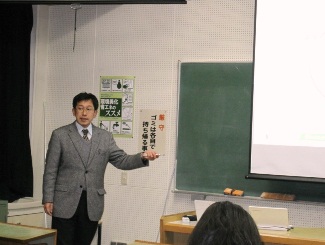
Professor, Institute of Engineering, Hiroshima University
- Chair:
Machi KANNA
Assistant Professor, Institute of Engineering, Hiroshima University
- Lecture:
Yuki FUKUDA
M2 Student,Graduate School of Engineering, Hiroshima University
"Hydrothermal pretreatment of food waste"
|
In Thailand, 1.6 million ton of food waste is generated every day. From the environmental and economic viewpoint, there is requirement to convert such food waste to other useful forms. Ethanol production from food waste can be a possibility, where starch and cellulose could be conducted into sugars, and then fermented by yeast. For this process, however, contamination of other component such as fat, protein, salt, etc., can affect the scarification. In this study, I researched effect of food waste component by experiment. |
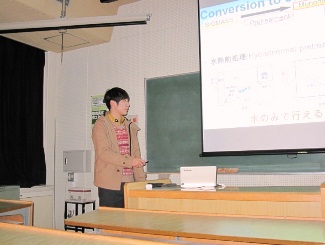 |
- Lecture:
Kim Hazel V. Arafiles
M1 Student,Graduate School of Advanced Sciences of Matter, Hiroshima University
"Production of high-value added lipids using brown seaweed extract by the marine protists, thraustochytrids"
|
Marine biomass like seaweeds are a good alternative biomass resource for fermentation technologies due to their cheap nature and un-competitiveness with the food supply. However, novel strategies still need to be conceptualized in order to break down these seaweeds’ unconventional sugar constituents so they can be used as substrates to produce valued fermentation products. This study, therefore, focused on the development and evaluation of a two-stage fermentation system that will convert mannitol extracted from the brown seaweed Konbu (Saccharina japonica) into the antihypertensive polyunsaturated fatty acids (PUFA like docosahexaenoic acid, DHA) and antioxidating carotenoids (like astaxanthin) using the mannitol-oxidating bacteria and the PUFA and carotenoids producing thraustochytrid, Aurantiochytrium sp. Upon testing the system in test tube- and flask-scale experiments, the thraustochytrid’s growth and productivity was better when grown in culture media made from Konbu extracts than that of pure mannitol. And upon scaling up the experiment to the jar fermenter level, the maximum amount of DHA and astaxanthin produced was at 53.5 and 18.0 mg/L, respectively. This proposed strategy, therefore, demonstrates that brown seaweed sugars can be effectively used as cheap substrates in order to produce high-value added products like DHA and astaxanthin using microorganisms as biocatalysts. |
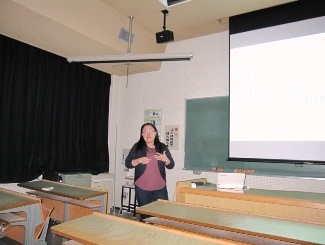 |
- Lecture:
Naruhiro FURUSE
B4 Student,Faculty of Engineering, Hiroshima University
"Cellulose pulverization under hydrothermal pretreatment using ball mill"
|
Cellulose was pulverized under hydrothermal condition using ball mill to clarify the behavior of cellulose during simultaneous pulverization and hydrothermal pretreatment of lignocellulosic biomass. By further treating the product with enzymatic treatment, the effectiveness of this treatment on glucose productivity of the cellulose was determined. High temperature was effective, but rotation speed and ball loading did not have large effect on glucose productivity for the conditions studied here. |
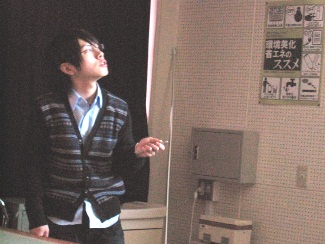 |
- Lecture:
Kouki SAKIMOTO
B4 Student,Faculty of Engineering, Hiroshima University
"Characteristics of simultaneous saccharification and fermentation (SSF)
and separate hydrolysis and fermentation (SHF) of cellulose powder"
|
Cellulose was treated by simultaneous saccharification and fermentation (SSF) and separate hydrolysis and fermentation (SHF). In SSF enzymatic hydrolysis and fermentation are performed in same reactor. In (SHF) there are three steps to get bioethanol, hydrothermal treatment, enzymatic treatment and fermentation. In this study SSF and SHF was conducted using cellulose powder at 30, 35, and 40℃. The concentration change of glucose was mostly the same when for temperature was change from 30 to 40 ℃. At 30℃, the highest ethanol concentration was obtained for both SSF and SHF. |
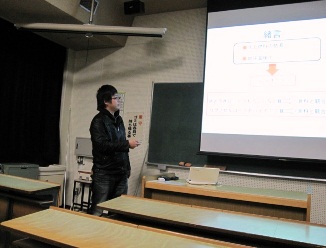 |
[Inquiries about this article]
Graduate School of Engineering, Hiroshima University
Y.NAKASHIMA
Mail: y4naka [AT] hiroshima-u.ac.jp
(Please replace [AT] with @)

 Home
Home